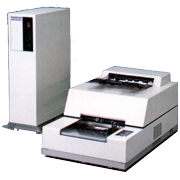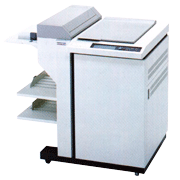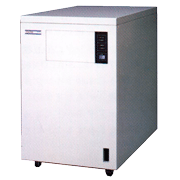In July 1985 Fujitsu announced the FACOM 6678A and FACOM 6678B (B1/B2), which were image character readers (dubbed VIRs, which stood for versatile information reader), and the FACOM 6679A, a handwritten character reader. These products were part of the component lineup for Fujitsu’s JEF (Japanese processing Extended Feature) online input system and image processing system.
The FACOM 6678A/B were capable of scanning image data and recognizing characters (letters, numbers, katakana characters, and symbols). In terms of processing speeds, the FACOM 6678A could process up to about 20 sheets per minute and the FACOM 6678B could process up to about 25 sheets per minute. The 6678A could handle originals up to A4 in size, while the 6678B could handle originals as large as A3.
The FACOM 6679A handwritten character reader was an optional unit that received image data from a FACOM 6678A/B and recognized handwritten characters in the image data. The FACOM 6679A’s main features were as follows:
- The reader recognized approximately 3,200 characters, including approximately 3,000 kanji characters (standard kanji characters plus additional characters for names and addresses) and non- kanji characters (letters, numbers, kana characters, and symbols).
- Multiple compression [Note 1] and partial patterning [Note 1] techniques were used for recognition.
- Fast character recognition (40 characters per second) was achieved with specialized recognition hardware.
- The 6679 compared words with a built-in dictionary (containing addresses, surnames, and first names) to achieve higher recognition rates.
- A user customizable dictionary was provided to enable comparisons with specific company names, product names, and other words.
Note 1: Multiple compression and partial patterning are both techniques for identifying similarities in recognition targets. They were used for recognizing kanji characters that have a high degree of complexity. In addition to the sheer number of kanji characters, there are different characters that have very similar shapes due to common radicals. And adding in the many handwriting fluctuations, it is not easy to identify handwritten kanji characters.
The multiple compression technique first narrows down the effective image information (slopes of line segments, the number of strokes, the distribution of dots, etc.) of a character. It then uses the distinctive sum of these elements to find the character in a character dictionary. How the elements are selected is the key to improving the recognition rate and the processing speed.
The partial patterning technique emphasizes differences in the non-radical portion of a kanji character and was used alongside the multiple compression technique.




